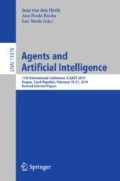Abstract
The purpose of this paper is to consider and formalize an important factor of human intelligence, belief affected by passion, which we call narrow-minded belief. Based on Public Announcement Logic, we define our logic, Logic Of Narrow-minded belief (LON), as that which includes such belief. Semantics for LON is provided by the Kripke-style semantics, and using this semantics, we formally analyze the mental state of the hero of Shakespeare’s tragedy Othello as an example of narrow-minded belief and its formalization. A proof system for it is given by a Hilbert-style proof system. In addition to that, we provide a complete labelled sequent calculus for LON based on the Hilbert-style proof system, and it syntactic cut elimination theorem is shown.
Access this chapter
Tax calculation will be finalised at checkout
Purchases are for personal use only
Notes
- 1.
If we follow the outermost strategy, six additional axioms (e.g, axioms for reducing combination of \([\flat A][\sharp B]\) and \([!A][\flat B]\) etc.) are required.
- 2.
We add one more comment for a technical difference between the two strategies. In the outermost strategy of public announcement logic, we need to include axiom like (RA!6) to reduce sequential announcement operators into a single, but the inference rule of (Nec[!]) is derivable. On the other hand, the rule is indispensable in the case of the innermost strategy, instead of economizing the number of axioms.
References
Artemov, S., Protopopescu, T.: Intuitionistic epistemic logic. Computer Science Technical Reports Paper 401 (2014)
Aucher, G.: A Combination System for Update Logic and Belief Revision. Master’s thesis, University of Amsterdam (2003)
Baltag, A., Fiutek, V., Smets, S.: Beliefs and evidence in justification models. In: Beklemishev, L., Demri, S., Máté, A. (eds.) Advances in Modal Logic, vol. 11, pp. 156–176. CSLI Publications (2016)
van Benthem, J.: Logical Dynamic of Information and Interaction. Cambridge University Press, Cambridge (2011)
van Benthem, J., van Eijck, J., Kooi, B.: Logic of communications and change. Inf. Comput. 204(11), 1620–1662 (2006)
van Benthem, J., Velázquez-Quesada, F.R.: The dynamics of awareness. Synthese 177(5), 5–27 (2010)
Damasio, A.: Descartes’ Error: Emotion, Reason, and the Human Brain. Avon books, New York (1994)
Dastani, M., Lorini, E.: A logic of emotions: from appraisal to coping. In: Proceedings of the 11th International Conference on Autonomous Agents and Multiagent Systems, vol. 2, pp. 1133–1140 (2012)
van Ditmarsch, H.: The Ditmarsch tale of wonders-the dynamics of lying. In: Reasoning About Other Minds: Logical and Cognitive Perspectives, vol. 65 (2011)
van Ditmarsch, H., Hoek, W., Kooi, B.: Dynamic Epistemic Logic. Springer, Dordrecht (2008). https://doi.org/10.1007/978-1-4020-5839-4
Eger, M., Martens, C.: Character beliefs in story generation (2017). https://aaai.org/ocs/index.php/AIIDE/AIIDE17/paper/view/15852
van Eijck, J., Renne, B.: Update, probability, knowledge and belief. In: Beklemishev, L., Demri, S., Máté, A. (eds.) Advances in Modal Logic, vol. 11, pp. 551–570. CSLI Publications (2016)
Hume, D.: A Treatise of Human Nature. Oxford University Press, New York (1739)
Lorini, E., Schwarzentruber, F.: A logic for reasoning about counterfactual emotions. Artif. Intell. 175(3–4), 814–847 (2011)
Negri, S., von Plato, J.: Proof Analysis. Cambridge University Press, New York (2011)
Nomura, S., Arai, N., Tojo, S.: The dynamics of narrow-minded belief. In: Proceedings of the 11th International Conference on Agents and Artificial Intelligence, ICAART, vol. 2, pp. 247–255. INSTICC, SciTePress (2019). https://doi.org/10.5220/0007394502470255
Nomura, S., Sano, K., Tojo, S.: Revising a labelled sequent calculus for public announcement logic. In: Yang, S.C.-M., Deng, D.-M., Lin, H. (eds.) Structural Analysis of Non-Classical Logics. LASLL, pp. 131–157. Springer, Heidelberg (2016). https://doi.org/10.1007/978-3-662-48357-2_7
Ono, H., Komori, Y.: Logics without contraction Rule. J. Symbolic Logic 50(1), 169–201 (1985)
Plaza, J.: Logic of public communications. In: Proceedings of the 4th International Symposium on Methodologies for Intelligent Systems: Poster Session Program, pp. 201–216 (1989)
Velázquez-Quesada, F.R.: Dynamic epistemic logic for implicit and explicit beliefs. J. Logic Lang. Inf. 23(2), 107–140 (2014)
Voorbraak, F.: As far as I know–epistemic logic and uncertainty. Ph.D. thesis, Utrecht University (1993)
Williamson, T.: On intuitionistic modal epistemic logic. J. Philos. Logic 21(1), 63–89 (1992)
Author information
Authors and Affiliations
Corresponding author
Editor information
Editors and Affiliations
Rights and permissions
Copyright information
© 2019 Springer Nature Switzerland AG
About this paper
Cite this paper
Nomura, S., Arai, N., Tojo, S. (2019). Dynamics of Narrow-Minded Belief and Its Cut-Free Sequent Calculus. In: van den Herik, J., Rocha, A., Steels, L. (eds) Agents and Artificial Intelligence. ICAART 2019. Lecture Notes in Computer Science(), vol 11978. Springer, Cham. https://doi.org/10.1007/978-3-030-37494-5_8
Download citation
DOI: https://doi.org/10.1007/978-3-030-37494-5_8
Published:
Publisher Name: Springer, Cham
Print ISBN: 978-3-030-37493-8
Online ISBN: 978-3-030-37494-5
eBook Packages: Computer ScienceComputer Science (R0)

